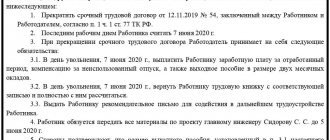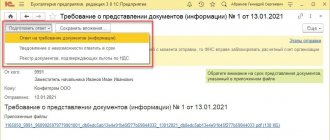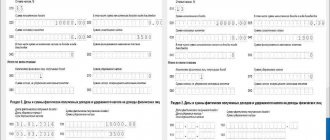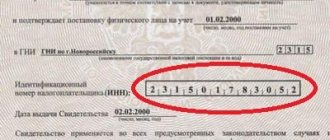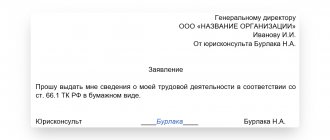While on maternity or child care leave, a woman may decide to terminate her employment relationship with her current employer. In addition, employees with children under 3 years of age may, in certain cases, be fired at the initiative of the employer.
Once a child reaches three years of age, there are practically no restrictions on dismissing an employee. In the article we will talk about the grounds for dismissal both at the initiative of management and at the request of the employee, as well as about the payments due to the woman in connection with the termination of the employment contract.
Dismissal after maternity leave
The entire time a woman is on leave for employment and labor, and then to care for a child, she retains her job. And if the need arises, a new employee is hired in her place to temporarily perform her duties. An employer cannot fire a woman on maternity leave on his own initiative. In this case, it will not matter whether the woman is a single mother or is raising a child in a complete family. A maternity leaver can only make a decision about dismissal herself. The only exceptions are situations when a woman works under a fixed-term contract, as well as liquidation of the employer company (
Downsizing and liquidation
If a company is in the process of reducing staff, then a woman has no benefits on leave for a child (up to 3 years old). However, such benefits remain for:
- pregnant women;
- employees on maternity leave for up to 1.5 years.
With a partial reduction, women caring for a child under 3 years of age may fall under clause 2 of Art. 81 Labor Code of the Russian Federation.
If the reduction is selective, then Art. 179 Labor Code of the Russian Federation. According to this article, the following employees have the advantage of remaining on staff:
- highly qualified;
- with high labor productivity.
Payments that the employer is obliged to make to the employee dismissed in this case.
| Pay | Characteristic | Term |
| Severance pay | Mandatory | On the last working day |
| Average earnings for three months (taking into account severance pay) | For the third month, upon application from the employment service and confirmation of registration as unemployed | Every month, subject to lack of employment |
Important! The financial source of all payments is the employer’s funds until the liquidation balance sheet is submitted and the company is removed from the register.
Dismissal at your own request
A young mother can resign of her own free will at any time. At the same time, she also retains the obligation to work for two weeks after writing the application. Often a woman writes an application much earlier than this period, so that this two-week period of time falls at the end of maternity leave, that is, so that in fact the woman does not have time to start work. The application is drawn up in the name of the director, it is written in free form. At the same time, the main condition in writing an application is to indicate the date of dismissal and the date of drawing up the document. Nothing more is required from the employee. Here is a sample of such a statement.
Statement: correct spelling
The application may be written by hand. The header contains the following information:
- to whom: write the position, full name of the person to whom the application is addressed, name of the organization;
- from whom: your position and full name.
The words "Statement" is the title. Then the wording is written: “I ask you to fire me of your own free will.” It is not necessary to write the reason.
Below: signature and date
You can add a clarifying entry: “I request the dismissal to be made “__”______ 2022.” Write a specific date. It must be calculated taking into account two weeks of work.
Document transfer methods:
- personally;
- by mail with a valuable letter with notification.
Calculation of compensation after dismissal: example
When dismissing a woman after maternity leave, she should be accrued certain payments (127 Labor Code of the Russian Federation). First of all, she needs to be paid compensation for her unused vacation time. In this case, the fact that the woman was on maternity leave will not matter. The payment calculation will be as follows:
First, you need to determine how much time the young mother spends working this year. For example, if she quits immediately after maternity leave, and before that she worked for less than 6 months, then she will retain the right to 14 days of vacation, for which compensation must be calculated.
After this, the time that the woman was on leave under the BiR is determined. In a normal case, the duration of such leave is 140 days, but if the birth was difficult, this period increases. For 140 days of maternity leave, the employee is entitled to 11.67 days of annual leave.
The next step is to determine the employee’s average earnings. To do this, the total amount of payments to the employee for 12 months is divided by 12 months, and then by 29.4. As a result, we will receive the amount of average daily earnings.
To determine the amount of compensation due, the amount of average daily earnings is multiplied by the number of vacation days for which the woman is entitled to compensation.
If an employee writes a letter of resignation after maternity leave, then the calculation of compensation will be different. You need to make the calculation as usual. Those days that the woman was on vacation will not be included in the calculation. And the time spent by the employee at home will not be included in the calculation.
An important point in this case will be determining the number of days of vacation required. If, for example, an employee had already used her allotted leave before dismissal, then she will not be compensated (
Algorithm for calculating severance pay
The calculation of average earnings in this case differs from the calculation of this value carried out to calculate compensation for unrealized vacation.
Basics of calculation:
- based on payments for the year preceding maternity leave or the period actually worked;
- basis: Resolution No. 922 of December 24, 2007
Formula for calculating benefits:
VP = D / OD,
where VP is severance pay: average monthly income to receive payments for the next 3 months of unemployment, etc.;
D – income equal to wages for the year that preceded the decree, with the exception of payments under Resolution No. 922, etc.;
OD – the total number of days worked during the year that preceded the start of the maternity leave, according to the schedule, days.
Example No. 2. Initial data:
- salary 30 tr;
- 20% bonus;
- surcharge for harmful conditions - 15%;
- quarterly bonus – 50%.
Calculation:
- salary amount for the year: 30 * 12 = 360 TR;
- bonus amount: 30 * 0.2 * 12 = 72 tr;
- amount of allowance for harmful conditions: 30 * 0.15 * 12 = 54 tr;
- amount of bonuses: 30* 0.5 * 4= 60 TR;
- total amount of payments: 360+72+54+60 = 546 tr;
- amount per month: 546 / 12= 45.5 tr;
- amount per day: 45.5/29.3 = 1.55 tr;
- the benefit will be 45.5 tr.
Dismissal after maternity leave
An employer has no right to dismiss a woman with a child under 3 years of age on his own initiative. However, in some cases this may be possible. For example, if a fixed-term employment contract was concluded with a young mother. In this case, the woman has the right to extend it at her own request for the entire period of her pregnancy. To do this, she writes applications and submits them to the employer every 3 months. If no application is received from the woman, then the employer has the right to dismiss her. Immediately after giving birth, the manager can also dismiss the employee unilaterally, on the basis that maternity leave has no effect on the extension of a fixed-term contract. To dismiss the employer, it is enough to notify the woman about this 3 days before the dismissal. The woman must be notified in writing (
FAQ
Question No. 1. If a woman is on maternity leave, the employer forces her to write a letter of resignation of her own free will. What to do?
Answer: You should file a complaint with the State Tax Inspectorate.
Question No. 2. When are compensations paid?
Answer: Most benefits must be paid to the employee on her last day of work. At worst, the next day.
Question No. 3. Is it possible to release a woman on maternity leave from her position before the expiration of the two-week period?
Answer: Some provisions of the law provide for this possibility. But such norms do not apply to women on maternity leave or parental leave.
Question No. 4. What documents are issued to a dismissed woman on maternity leave?
Answer: Among such documents:
- employment history;
- a copy of the employment order (at the employee’s request);
- a copy of the transfer order (at the employee’s request);
- a copy of the employment contract (at the employee’s request);
- certificate 2-NDFL;
- certificate of income for the last three months;
- form SZV-STAZH.
Question No. 5. Can an employer refuse to dismiss an employee after returning from maternity leave?
Answer: There are no legal grounds for refusal in accordance with Article 80 of the Labor Code of the Russian Federation.
Question No. 6. While the employee was on maternity leave, tariff rates at the enterprise increased. The employee decided to quit after maternity leave for up to 1.5 years. Are rate increases being taken into account?
Answer: yes, since average earnings have increased.
Most common mistakes
Error No. 1. The boss may refuse to issue a work book and other documents. If this happens, you should go to court, since failure to comply with such employee requirements threatens the company with a fine of up to 500 rubles.
Mistake No. 2. The employee returned from maternity leave and decided to quit without working a single day. They refuse to pay her compensation for vacation, since she did not work all last year. But, if there was no earnings in the billing period, then the previous period is used for calculations.
Let's summarize. Modern Russian legislation is quite humane in relation to pregnant women and those on maternity leave. This category of citizens is protected from various troubles. The most important benefit is job security. However, in the case when a woman wants to quit, the law allows her to receive all the necessary compensation and payments from the employer.
Preparation and beginning of motherhood provides legal protection from termination of the contract on the basis of Article 261 of the Labor Code of the Russian Federation. Dismissal after maternity leave occurs on a general basis.
Women's rights on maternity leave
Important! Please keep in mind that:
- Each case is unique and individual.
- A thorough study of the issue does not always guarantee a positive outcome. It depends on many factors.
To get the most detailed advice on your issue, you just need to choose any of the options offered:
- Use the online chat in the lower corner of the screen.
- Call: Federal number: +7 (800) 511-86-74
Most of the working-age population in our country, in the old fashioned way, use the Soviet concept of “maternity leave,” meaning by it the period when a woman leaves work for a long time to give birth to a child and care for him. In fact, this rather long period is divided into three different periods:
- prenatal (70 days, in a standard situation), Art. 255 TK;
- postpartum (the same 70 days, if the woman in labor has no complications), Art. 255 TK;
- leave allowing a woman to concentrate on her newborn until he is three years old, art. 256 TK.
During the first two stages, the maternity leaver not only retains her place, but is also paid an average salary. For the time remaining until the baby's third birthday, up to 1.5 years, she receives benefits and remains confident that she will be able to return to her position at any time. Moreover, during this period she cannot be disturbed by news of reductions and other global changes at the enterprise, except for its complete liquidation, Art. 261 TK. Some categories of mothers and adoptive parents retain immunity from dismissal after maternity leave for much longer than three years. The employer will be able to take the initiative and calculate them of his own free will only in the event of flagrant violations on the part of the “beneficiaries”.
Deadlines
The law provides that writing a letter of resignation of one's own free will is a sufficient legal basis for its implementation.
It should be taken into account that if the employee subsequently did not want to leave and continued to work, then the validity of this document should be canceled.
On the other hand, let’s say the boss does not want to fire a valuable specialist and did not want to fire him. Then the employee simply does not continue to work after the date specified in the application and is considered dismissed by law, and the boss still has the responsibility to carry out the registration in accordance with the requirements of the law. This means issuing the appropriate order and filling out the corresponding pages of the work book, which must be issued personally to the former employee.
A situation is possible when, for some reason, you don’t want to wait 14 days, but leave your job right away. Of course, when the dismissal is formalized during maternity leave or after it, during the next paid vacation, this problem is not relevant if these days pass during the vacation period.
Although working for two weeks is an obligation provided for by law, the boss can nevertheless accommodate and reduce this period of time.
Payments
Upon dismissal, the employee must be given certain payments.
They will consist of the following amounts:
- If there is unpaid time worked, it must be compensated.
- In some cases, it happens that the employee has one or more vacations that he did not use. Upon dismissal, they are paid according to the average salary of the employee.
